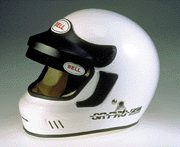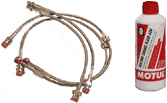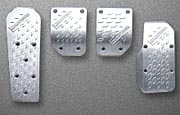Article Topics:
- Overview
- Intro to Racing
- Driving Technique
- Practice Sessions
- Driver’s Gear
- Vehicle Safety
- Handling
- Brakes
- Power
- Tools
TurnFast
recommends
these books:
Articles for Getting Started in Racing
Vehicle Modifications
If you haven't started modifying your car already, as soon as you start driving on the track, you'll be willing to mortgage your parent's house to get the money. However, to get the most out of racing, and to improve your drivings skills with the most bang for your buck, there's a certain approach to a car's modifications that makes the most sense.
As you make modifications to your vehicle, you should approach the changes in the following order. Make all necessary safety modifications possible. Next, make improvements to your brakes (while they may not be the most performance enhancing modification, they are often the weakest link in racing a street car, and good brakes offer increased safety and prevent repetitive breakdowns). Third, make the changes necessary to improve the handling of your car through the turns (you'll learn far more about driving by improving the handling of your car than by adding another 100 hp). Finally, increase the power of the car.
The suggestions below assume you are using your daily driver for occasional time trialing or autocrossing. These suggestions in this order are generalized. The brakes in some cars are quite sufficient for road racing, and may not need to be the first things changed. Some cars have very competent suspensions from the factory, and power might be the better place to spend money. For specific ideas on what your car needs most to improve its road racing performance, you should talk to a few car shops or clubs that are involved in racing, and are familiar with the type of car you have.
Safety Improvements
- Proper driver's gear -- helmet, gloves, shoes, and suit. You can start with the minimum requirements of your club, but a proper car helmet and gloves are essential.
- 4- or 5-point seat belts -- your car's 3-point belt is OK, but you're still going to slide around in your seat a lot, and let's face it, even on the street the 3-point belt isn't that great. Get an aftermarket 4-point belt if you have a stock seat. This will provide better support for your whole body under braking and cornering, and in case of an accident.
- Seat -- for improved stability under hard cornering, a seat with greater hip and shoulder support allows you to focus on driving and not hanging on. It also limits your body's motion in the event of an accident.
- Roll bar or cage -- with the exception of convertibles, most car clubs will not require one as their goal is to provide a way for street cars to get on a track. Today's cars are pretty decent in most low-speed, single rollover situations. If your car reaches corner speeds over 100mph, you should seriously consider getting a 4-point or better roll bar, or drive those corners a little below the limit. If you're willing to put a roll bar or cage in the car (which makes the back seats useless for passengers, then do it.
Brake Improvements
- Pedals (all) -- change them to allow heel/toe down shifting. (See the articles on Pedals and Heel-toe Downshift in the Driving Techniques tab for more information on this).
- High temperature racing brake fluid -- prevents fluid boiling and the fading of brake pressure that results
- Stainless steel brake lines -- prevents the fade caused by overheated and stretched stock rubber lines.
- Carbon or other racing pads (used during the event only) -- provides extra braking grip, and will not fail due to the high heat generated with repeated braking (however they will wear rotors faster).
- Slotted rotors -- reduces fading caused by buildup of brake dust between the pad and rotor.
- Increased rotor size -- provides greater leverage which increases braking power (and less wear)
- Multiple-piston calipers -- provides greater squeeze more uniformly over the pad for greater braking power (and less wear)
Handling
- Rear sway bar -- if your car tends to understeer in corners (most new cars do), getting a thicker rear sway bar will make a significant difference in reducing this, and will result in more traction overall
- Tower strut bars -- this will reduce body flex, and help keep the inside tires better planted on the track in a turn.
- Shocks -- generally, you'll want to change shocks and springs at the same time. If you can only afford one, then do the shocks, and get an easily adjustable kind. Adjustable shocks allow tuning of the handling characteristics.
- Springs -- stiffer springs that will lower the car 1-2" inches help to lower the car's center of gravity, and resist weight transfer for overall better traction. Most street cars will not handle well when lowered more than about 1.5" as it puts the suspension geometry too close to (or beyond) the limit of the designed working range.
- Tires -- a set of race compound tires can improve handling performance, in terms of lap times, as much as many of the above changes put together. However, they're only good on the track, and they need frequent replacing.
Power
- Intake -- power is a function of the amount of fuel, air, and spark. Most cars have plenty of fuel and spark capacity to start with. Allowing more air is the first place to start adding more power. The air filter and housing is the first thing to change.
- Exhaust -- more air in, means more air out. A properly designed, higher-flow exhaust will benefit any car immediately. The muffler, the piping between the catalytic converter and muffler, the piping to the catalytic converter, the exhaust manifold, and the catalytic converter itself, are usually the stages best followed.
- Spark -- better plugs, wires, and spark coils will increase the intensity of the spark in the cylinder chamber, burning more of the fuel and generating more power.
- Fuel -- higher flow injectors (or carburetor), and a higher flow/pressure fuel pump are generally not needed unless other engine modifications have significantly increased the potential air flow, but should follow major power modifications such as turbos, superchargers, higher compression pistons, bigger cams, etc.
Read Next Article (Driving Techniques)


No buts about it, your first money should be spent on a good helmet and quality gloves.

Your second purchases should most likely be for stainless brake lines and high temperature racing brake fluid. The brakes are typically the weakest link in racing a street car. Even for an expensive sports car, the repeated heavy braking of a road course can overheat the stock fluids and rubber lines.

For stick-shift cars, if your pedals are spaced too far apart to allow comfortable heel-toe operation of the gas and brake, you'll need to install after market pedals similar to these.
